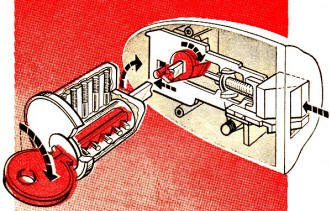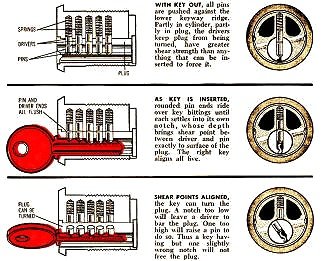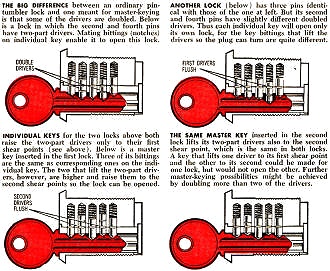|
June 1961 Popular Science
 [Table of Contents] [Table of Contents]
Wax nostalgic about and learn from the history of early
electronics. See articles from
Popular
Science, published 1872-2021. All copyrights hereby acknowledged.
|
Most people, even in this, the
year of our Lord 2024, still use old-fashioned cylinder locks on a regular basis.
Your abode's front door lock is almost certainly a cylinder lock, as is the
starter lock for your car. You likely have a metal key in your pocket or purse
for each. If you have recreational vehicles, chances are they are started with a
metal key in a cylinder lock. Variations on the basic design of a cylinder lock
have emerged which make them more difficult to pick, but fundamentally they are
mostly the same. We have all seen movies and television shows where clever
crooks, police, and private detectives pull out a professional
lock picking kit and jiggle a lock in mere
seconds, no matter whether it is an office door, a file cabinet, or a bank vault.
This 1961 Popular Science magazine article provides a good introduction
into cylinder lock construction and operation. Of course videos abound on
YouTube for learning the fine art of
lock picking. If you
want a good laugh, watch
this.
How a Cylinder Lock Works
 Key Part of a pin-tumbler cylinder lock is a cylinder or case
with an off-center hole. A plug slotted to receive the key turns in this. Drilled
cross-wise in both cylinder and plug, and aligned when the key is out, are five
small holes. Each contains a round-ended pin and a similar flat-ended driver. When
they are in line (key is shown turned at left) the pins are pushed into the keyway
by small springs. Inner end of the plug has a cam or a bar (as shown) engaging the
second lock element - the bolt mechanism. When the key turns the plug within the
cylinder, this cam or bar operates the mechanism, withdrawing the door bolt. Key Part of a pin-tumbler cylinder lock is a cylinder or case
with an off-center hole. A plug slotted to receive the key turns in this. Drilled
cross-wise in both cylinder and plug, and aligned when the key is out, are five
small holes. Each contains a round-ended pin and a similar flat-ended driver. When
they are in line (key is shown turned at left) the pins are pushed into the keyway
by small springs. Inner end of the plug has a cam or a bar (as shown) engaging the
second lock element - the bolt mechanism. When the key turns the plug within the
cylinder, this cam or bar operates the mechanism, withdrawing the door bolt.
Plug cannot be turned until each pin is raised to an exact height
With Key Out, all pins are pushed against the lower keyway ridge.
Partly in cylinder, partly in plug, the drivers keep plug from being turned, have
greater shear strength than anything that can be inserted to force it.
As Key is Inserted, rounded pin ends ride over key bittings
until each settles into its own notch, whose depth brings shear point between driver
and pin exactly to surface of the plug. The right key aligns all five.
Shear Points Aligned, the key can turn the plug. A notch too
low will leave a driver to bar the plug. One too high will raise a pin to do so.
Thus a key having but one slightly wrong notch will not free the plug.
Invented by the Egyptians at least 4,000 years ago, the first pin-tumbler lock
was not a cylinder type. It had a bolt secured by concealed wooden pins. A key with
pegs spaced exactly like the pins raised them flush with the bolt, which could then
be drawn.
For centuries, locksmiths exerted ingenuity in other directions. Some bolstered
the security of poor locks with booby traps that cut off fingers, or trapped or
shot would-be lock pickers. Others added fake keyholes, or built in dual or triple
key movements.
In the 1860s Linus Yale Jr. patented improvements on a cylinder lock invented
earlier by his father, a builder of bank locks. The resulting Yale cylinder lock
was the first mass-produced one to offer real security, plus master-keying.
Top example of this is the system devised by Yale & Towne for the United
States Air Force Academy. Each cadet has a key that fits only his own locks. A sub-master
key opens all locks in one dormitory corridor. Increasingly large groups of locks
can be opened by master, grand-master, and great-grand-master keys.
A closely guarded great-great-grand-master key, available only to top-ranking
officers, can open any of the thousands of locks used throughout the academy. Details
of the system are secret, but the drawings below show the principle of master-keying.
Why a master key can open different locks
The Big Difference between an ordinary pin-tumbler lock and
one meant for master-keying is that some of the drivers are doubled. Below is a
lock in which the second and fourth pins have two-part drivers. Mating bittings
(notches) on individual key enable it to open this lock.
Individual Keys for the two locks above both raise the two-part
drivers only to their first shear points (see above). Below is a master key inserted
in the first lock. Three of its bittings are the same as corresponding ones on the
individual key. The two that lift the two-part drivers, however, are higher and
raise them to the second shear points so the lock can be opened.
Another Lock (below) has three pins identical with those of
the one at left. But its second and fourth pins have slightly different doubled
drivers. Thus each individual key will open only its own lock, for the key bittings
that lift the drivers so the plug can turn are quite different.
The Same Master Key inserted in the second lock lifts its two-part
drivers also to the second shear point, which is the same in both locks. A key that
lifts one driver to its first shear point and the other to its second could be made
for one lock, but would not open the other. Further master-keying possibilities
might be achieved by doubling more than two of the drivers.
Posted May 9, 2024
|












